Notalar Nasıl Okunur?
Bu makalede, nota okuma ile ilgili tüm temel bilgileri öğreneceksiniz. Tiz ve bas nota anahtarlarını tanıyacak, notaları okuma ve ritmi anlama becerisi kazanacaksınız. Her açıklama, klasik, pop ve caz repertuvarlarından çeşitli parçalarla video biçiminde sunulan bazı egzersizler içermektedir.
Daha ileri gitmek isterseniz, müzik öğretmeni ve Lozan Konservatuvarı Dekanı Angelo Lombardo tarafından tasarlanan ve Tomplay tarafından yayınlanan Theory'yi keşfedin adlı öğretim metodunu keşfedebilirsiniz.
Tiz ve Bas Nota Anahtarları - Nota Okumayı Öğrenmek
Bir nota parçasını okumaya başlamadan önce, çizgi ve nota anahtarı sistemini anlamak çok önemlidir. Özellikle tiz ve bas nota anahtarlarını tanımak, müziğin çoğunda kullanılan temel bilgilerdir.

Bir stave (porte), beş yatay çizgiden ve dört boşluktan oluşur. Bu çizgi ve boşluklar, notaların perde yüksekliğini belirlemek ve onları okuyabilmek için kullanılır.
Birbirine parantezle bağlanmış iki veya daha fazla stave grubuna sistem denir. Bu düzenlemeye örnek olarak piyano notaları verilebilir. Piyano notalarında, üst satır tiz notalar içindir ve sağ el tarafından çalınır. Alt stave ise sol elin çaldığı bas notaları gösterir.
(Bu bilgi, yeni başlayanlar için temel bir referans olarak sunulmuştur. Daha fazla deneyim kazandıkça, bu kavramlar daha derinlemesine ele alınabilir.)
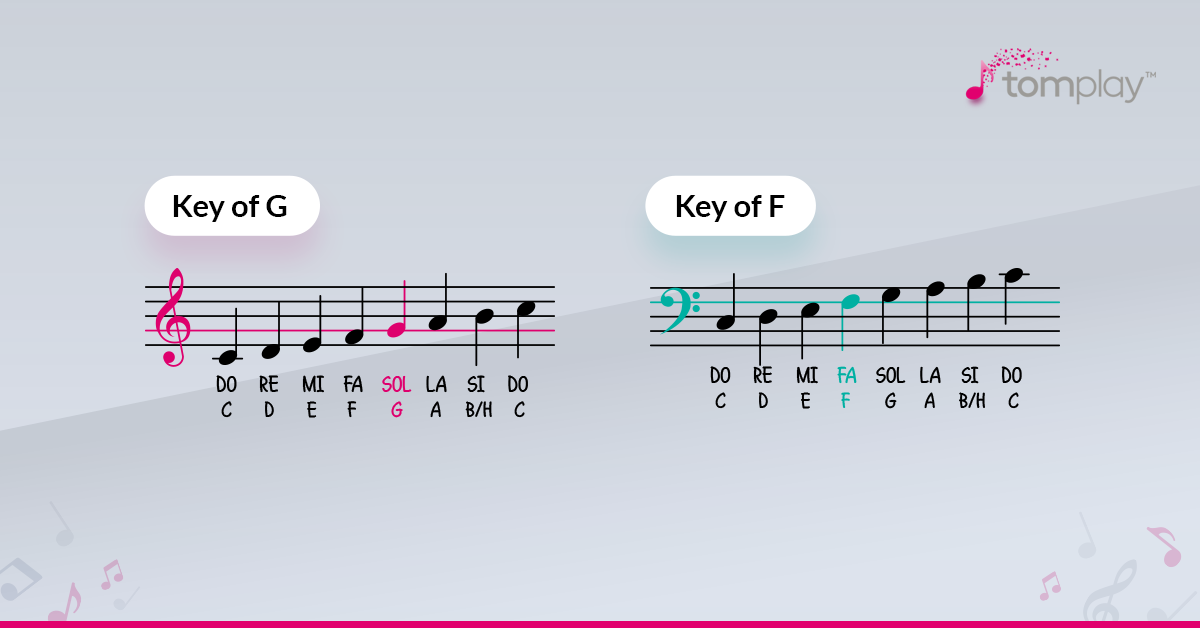
Tiz nota anahtarı en yaygın olanıdır. Bir piyano klavyesiyle ilişkilendirildiğinde, orta Do'nun sağında yer alan daha yüksek notaları gösterir (aşağıda gri renkte belirtilmiştir).
Tiz anahtarın başlangıç noktası, Sol notasının konumunu gösterir: alttan ikinci satırda.
Bas nota anahtarı, orta Do'nun solunda yer alan daha düşük notaları gösterir.
Bas nota anahtarının başlangıç noktası, Fa notasının konumunu gösterir: üstten ikinci satırda.
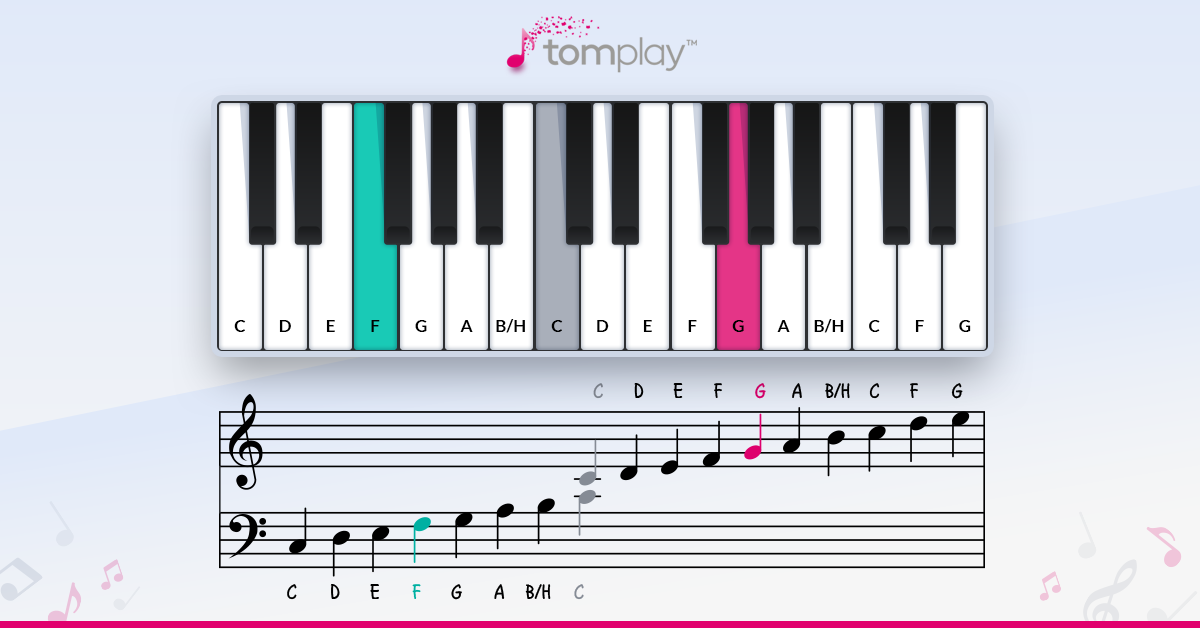
Orta Do'nun (yukarıda gri renkte) hem tiz hem de bas nota anahtarında üzerinden geçen bir çizgiye sahip olduğunu fark ettiniz mi? Bu çizgi, dizekler (stave'ler) arasında hayali bir ek çizgiyi temsil eder ve orta Do'yu müzik sayfasında bulmayı kolaylaştırır. Ayrıca, bas nota anahtarının üstünde ve tiz nota anahtarının altında konumlanır.
Tiz nota anahtarındaki Sol notasını, bas nota anahtarındaki Fa notasını ve orta Do notasını tanıyabilmek, notaları okuyabilmek için sağlam bir temel oluşturduğunuz anlamına gelir.
Eğer henüz bilmiyorsanız, notaların isimlerini ezbere öğrenin. Bu, 7 notadan oluşan bir seridir ve buna "oktav" denir. Yukarı çıkarken meşhur "do-re-mi-fa-sol-la-si-do" (veya C-D-E-F-G-A-B-C) dizisiyle, aşağı inerken ise "do-si-la-sol-fa-mi-re-do" (C-B-A-G-F-E-D-C) dizisiyle ifade edilir. Bu bilgiyi öğrenmek, size büyük fayda sağlayacaktır!
Aşağıdaki videoya tıklayarak notaları yüksek sesle söyleme alıştırması yapabilirsiniz:
Gördüğünüz gibi, notalar çizgiler ve boşluklar üzerinde dönüşümlü olarak yer alır. Tanıdık bir nota bulun ve her satırda veya boşlukta nota nota sayarak yukarı çıkın ya da aşağı inin. İlk seferde bunu başaramazsanız endişelenmeyin! Beyninizin bu işlemi otomatikleştirmesi gerekir ve bu nedenle tekrar gereklidir. Biraz pratikle, giderek daha fazla notayı ezbere tanıyacaksınız!
Sıra sizde! Nota okumayı öğrenmek için alıştırmalarımızı keşfedin:
Artık notaları, kendi satırlarında veya boşluklarında nasıl bulacağınızı biliyorsunuz. Aşağıdaki iki parçada notaların adını yüksek sesle okuma alıştırması yapın. Her videoda, önce alıştırma bölümü ve ardından notaların adlarının gösterildiği düzeltme bölümü yer alacaktır. Bu, TomTheory yönteminden bir alıntıdır. Tüm alıştırmalara erişmek isterseniz, TomTheory metodunu buradan satın alabilirsiniz.
Alıştırma No. 1 - "Dağın etrafından dolaşacak":
Gördüğünüz gibi, notalar sırayla çizgilerde ve aralıklarda yer alır. Nota kağıdınızda tanıdık bir nota bulun ve yukarıya ya da aşağıya doğru her çizgi ve aralıktaki notayı tek tek sayın. İlk denemede başaramazsanız, pes etmeyin! Beyninizin bunu otomatik olarak öğrenmesi gerekiyor, bu yüzden tekrar etmek önemlidir. Biraz pratikle daha fazla notayı ezbere tanıyacaksınız!
Sıra sizde! Nota okumayı öğrenmek için egzersizlerimizi keşfedin:
Artık notaların kendi çizgi veya aralıklarında nasıl bulunduğunu biliyorsunuz, aşağıdaki iki parçada notaların isimlerini yüksek sesle okuyarak pratik yapın. Her videoda, egzersiz bölümü ve ardından notaların isimlerinin gösterildiği düzeltme bölümü bulunmaktadır.
Bu metin, TomTheory yönteminden bir alıntıdır. Tüm egzersizlere erişim sağlamak isterseniz, TomTheory yöntemini buradan satın alabilirsiniz.
Egzersiz No. 1 - "She'll be coming round the mountain":

Alıştırma No. 2 - "Bingo":

Alıştırma No. 3 - "Ne Harika Bir Dünya":

Egzersiz No. 4 - Schubert'in Ave Maria'sı:

Nota değerleri, ritim imzası
Her notanın şekline veya rengine göre farklı bir uzunluğu vardır: bu ritmin temelidir.
Claude Debussy'nin dediği gibi, "müzik notalar arasındaki sessizliktir". Çalmadığınız zaman, notaların yerini farklı şekil ve uzunluklara sahip duraklamalar alır.
Şimdi farklı değerlere bir göz atalım:
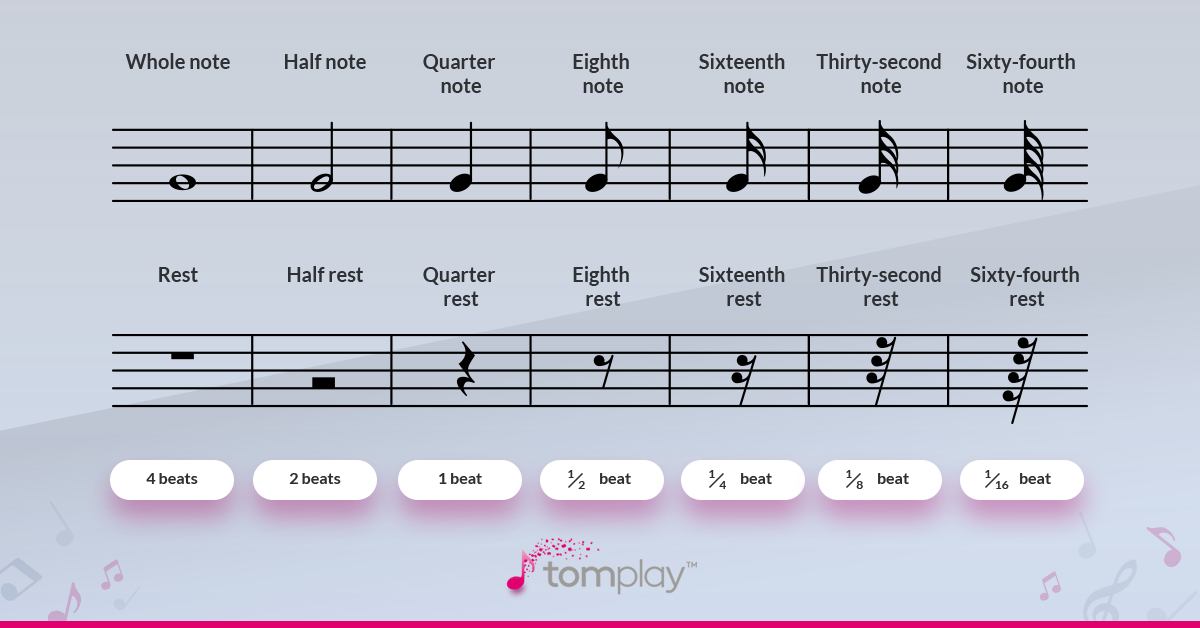
Tıpkı 1+1 = 2 veya 2+2 = 4 gibi, bu değerler de birbirlerine karşılık gelir. Bir göz atın:

Bir tam nota, iki yarım notaya eşittir; bu da dört çeyrek notaya ve sekiz sekizlik notaya eşittir ve bu şekilde devam eder!
Bu ritimlerin farklı değerlerini ölçmek için vuruşları kullanırız. Örneğin, bir metronom kullanmak, her seferinde düzenli bir şekilde vuruş yaparak ritim içinde çalmanıza yardımcı olur. Bu vuruşların arka arkaya çalınma hızına (ve dolayısıyla müziğin hızına) tempo denir.
Ritmi okumayı kolaylaştırmak için, notaları (ve dolayısıyla değerlerini) dizek (stave) üzerinde dikey çizgilerle gruplara ayırırız: bunlara ölçüler denir.
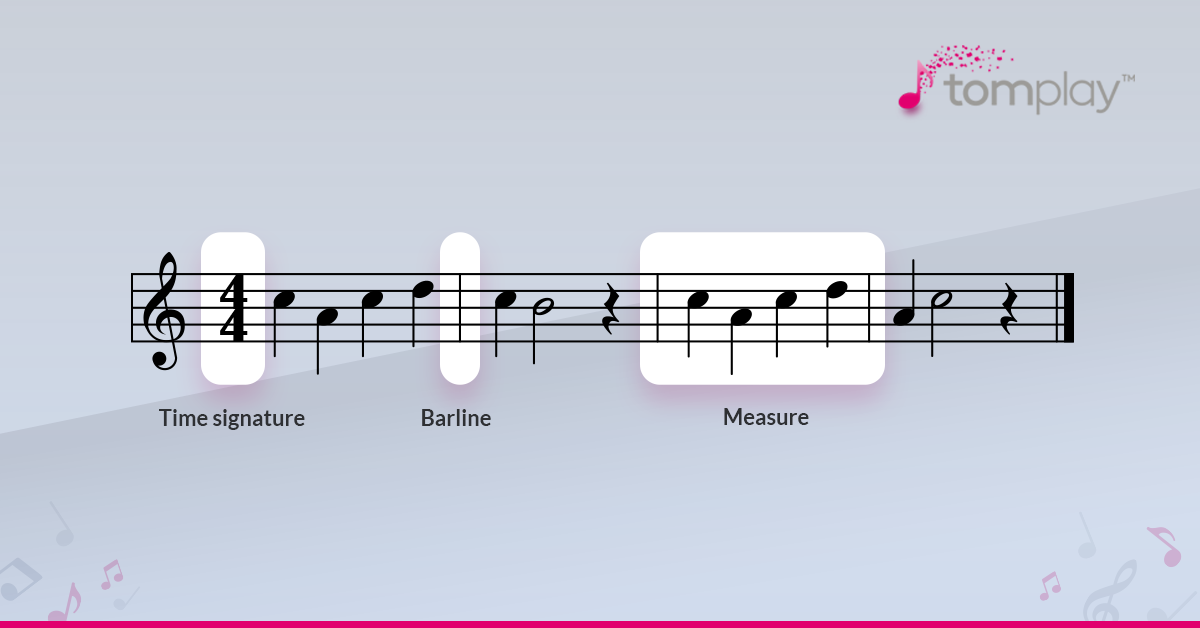
Bu değerlerin ne anlama geldiğini anladınız mı? Harika! Peki ya dizeğin başında, tiz nota anahtarından hemen sonra yer alan bu rakamlar ne anlama geliyor? Bu rakamlar, bir parçanın her ölçüsünde kaç vuruş olduğunu ve bu vuruşların ne tür bir birimle ölçüldüğünü belirlememizi sağlar. Buna ölçü zamanı denir!
Çubuğu veya ölçü zamanını anlama
4/4'lük ölçü zamanı bize şunu ifade eder:
- Üstteki rakam, her bir ölçüdeki vuruş sayısını gösterir: burada 4 vuruş vardır. Yani, bu 4 vuruşluk bir ölçüdür!
- Alttaki rakam, tam notanın kaçta kaçının bir vuruşu temsil ettiğini gösterir: burada 1/4 yani çeyrek nota vuruş birimi olarak kabul edilir.
Bu nedenle, 4/4'lük bir ölçüde:
- 4 vuruş vardır,
- ölçü birimi: tam nota,
- vuruş birimi: çeyrek nota.
Bu temel kurallar sayesinde bir müzik parçasındaki ritmi daha iyi anlayabilir ve okuma becerinizi geliştirebilirsiniz.
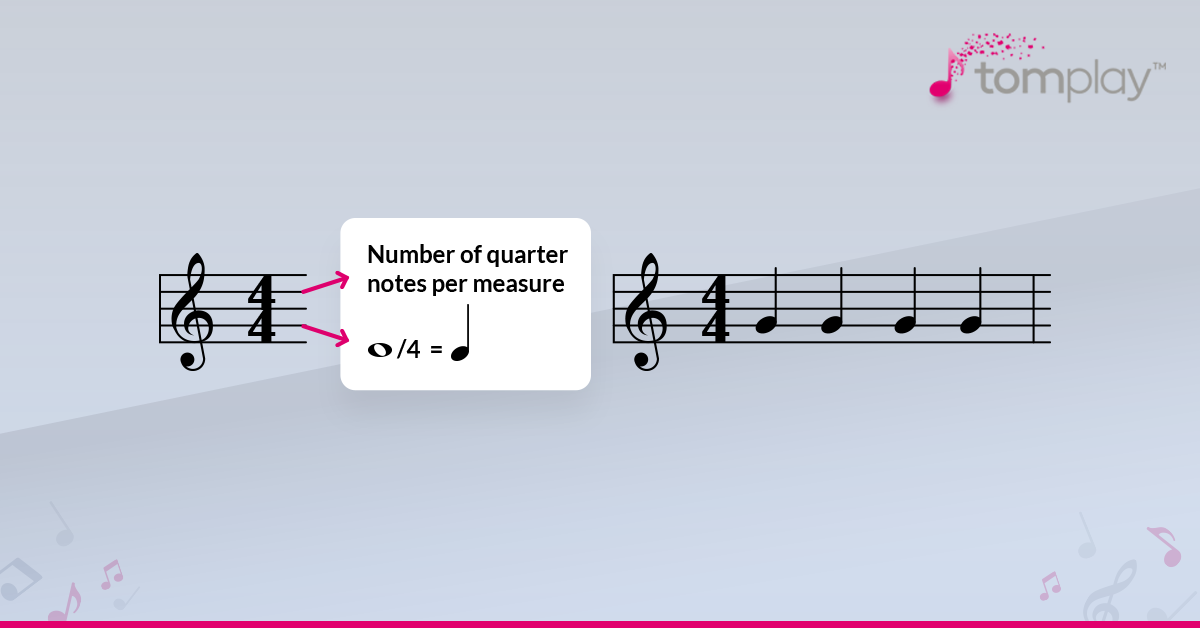
Ölçü başına 4 çeyrek nota içeren 4 vuruşlu bir ölçüdür.
? 4 vuruşluk bir ölçüyü temsil etmenin başka bir yolu daha vardır: C
Gelin birlikte bazı yeni ölçüm sürelerine bakalım:
2/2 ölçüm zamanı anlamına gelir:
- 2 vuruşlu bir ölçü
- Ölçü birimi: bir tam nota
- Vuruş birimi: çeyrek nota
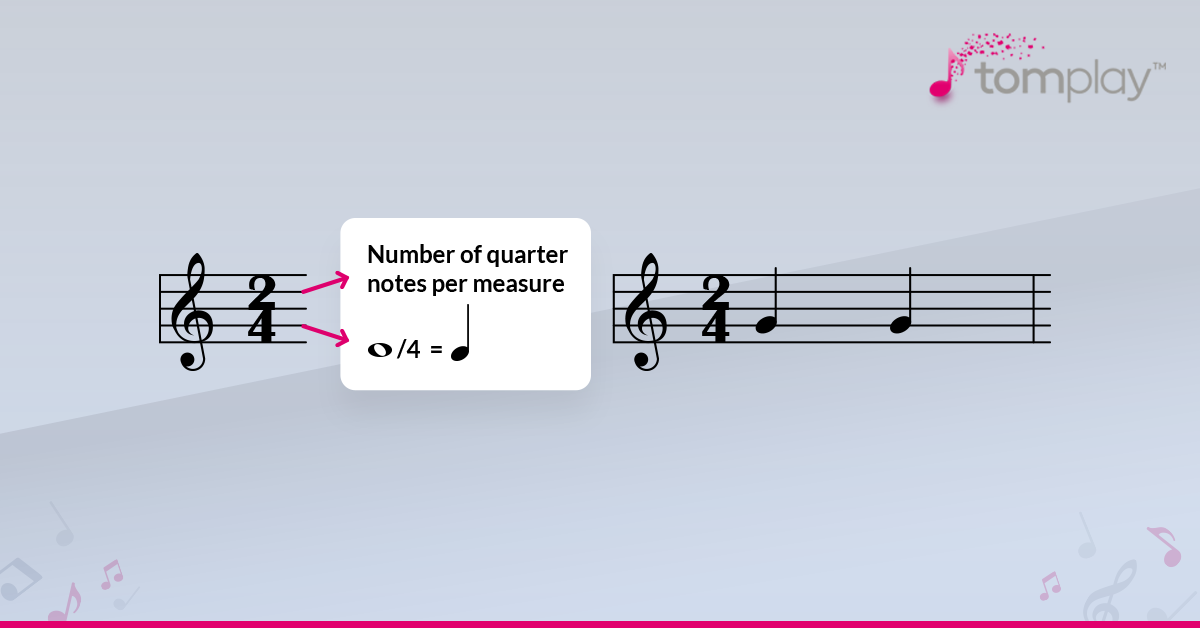
Bu, ölçü başına 2 çeyrek nota içeren 2 vuruşlu bir ölçüdür.
3/4 ölçü zamanı anlamına gelir:
- 3 vuruşlu bir ölçü
- Ölçü birimi: bir tam nota
- Vuruş birimi: çeyrek nota
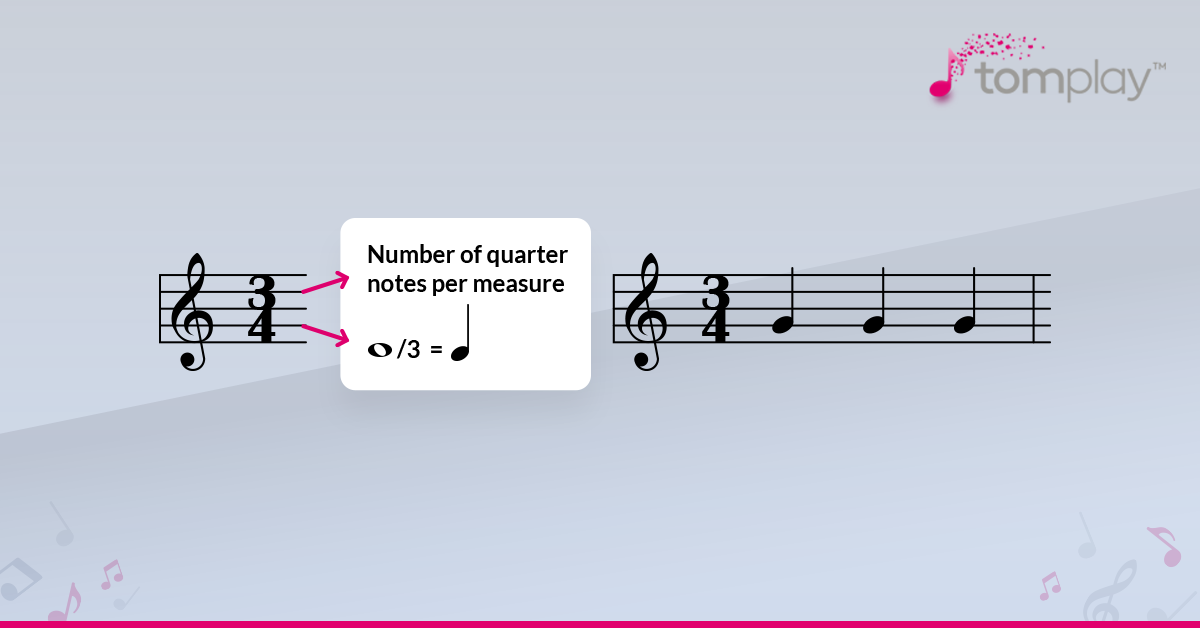
Bu, ölçü başına 3 çeyrek nota içeren, 3 vuruşlu bir ölçüdür.
Dikkat! Yukarıdaki ölçüler, çeyrek notalar için geçerlidir. Diğer ölçü sürelerini keşfetmek için metodun tamamını indirmenizi öneririz!
Sıra sizde! Ritmi alkışlamayı öğrenmek için egzersizlerimizi keşfedin.
Artık ritmi nasıl okuyacağınızı anladınız. Şimdi, aşağıdaki ritim alıştırmalarını kullanarak pratik yapabilirsiniz. Her videoda, önce alıştırma bölümü, ardından ritmin yüksek sesle söylendiği düzeltme bölümü yer alır. Notalar ekranınızda kayarken, ritmi işaretlemek için ellerinizi birbirine veya masaya vurun.
Bu, TomTheory metodundan bir alıntıdır. Tüm alıştırmalara erişmek isterseniz, TomTheory metodunu buradan satın alabilirsiniz.
Alıştırma No. 1 - Çeyrek ve yarım notalar:

Egzersiz No. 2 - Çeyrek dinlenme

Alıştırma No. 3 - Bütün nota:

Alıştırma No. 4 - Noktalı yarım nota:

Daha ileri gidin: Notaları ritimle söyleyin!
Artık notaları nasıl okuyacağınızı ve ritmi nasıl hesaplayacağınızı biliyorsunuz. Şimdi yapmanız gereken tek şey, bu iki beceriyi birleştirmek ve notaları ritimle söylemek!
Nota okumayı kolaylaştırmak için, tanınmış parçalardan alınan aşağıdaki ek alıştırmaları keşfedin. Bu alıştırmalarda, notaların adını yüksek sesle söyleyin ve notalar ekranınızda kayarken aynı anda ritmi alkışlayın. Üzerinde çalışılacak pasajlar renkli olarak vurgulanmıştır.
Bu, TomTheory metodunu buradan Tüm alıştırmalara erişmek isterseniz, TomTheory metodunu buradan satın alabilirsiniz.
Alıştırma No. 1 - "Parıl Parıl Küçük Yıldız":

Alıştırma No. 2 - "Avignon köprüsü üzerinde":

Alıştırma No. 3 - "Hallelujah":

Alıştırma No. 4 - "Titanik":

Alıştırma No. 5 - Pachelbel'in Kanonu:

Bu makale sayesinde nota ve ritim okuma hakkında daha fazla şey öğrenebildiğinizi umuyor ve TomTheory metoduyla müzik okuma pratiği yaparken ve Tomplay ile enstrümanınızı kullanırken size bol keyif diliyoruz!
TomTheory - müzik okumak için interaktif yöntem
TomTheory, Lozan Konservatuvarı öğretmeni ve Dekanı Angelo Lombardo tarafından tasarlanan ve Tomplay tarafından yayınlanan, müzik eğitimi için ilerici ve kapsamlı bir yöntemdir.
Bu yöntem, yalnızca müzik ve ritim okumaya yönelik alıştırmalar sunmakla kalmaz, aynı zamanda öğrencilerin enstrüman çalma veya şarkı söyleme ile müzik okuma arasındaki bağlantıyı kurmalarına yardımcı olan müzik repertuarından seçilmiş parçalar da içerir.
TomTheory yöntemini buradan keşfedin!



Bir yorum ekle...